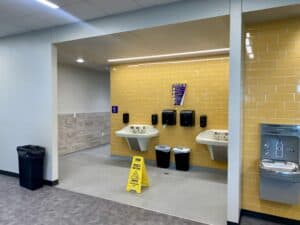When it comes to training, adhering to a structured and systematic learning approach can greatly enhance the effectiveness and safety of the training provided.
The ‘Tell, Show, Do, Review’ method is a proven training model that we implement in our firearms, tactics, and emergency response courses to ensure that our learners not only grasp theory but also develop practical skills and competencies that are critical in real-world situations.
In the ‘Tell’ phase of our training, we start by providing a solid foundation of the necessary theoretical knowledge. This includes understanding the mechanics of firearms, safety protocols, and tactical theories. This stage is crucial as it sets the groundwork for the subsequent, more hands-on stages of the training.
During the ‘Show’ phase, our instructors demonstrate the techniques and tactics covered in the ‘Tell’ stage, allowing trainees to observe these skills in action. This visual representation is vital for bridging the gap between theory and practice.
Moving forward to the ‘Do’ phase, trainees are given the opportunity to perform what they have learned under close supervision. Here they apply shooting techniques, weapon handling, and tactical movements, gaining hands-on experience.
The ‘Review’ stage is where we provide feedback, discuss outcomes, and reinforce lessons learned. This evaluation is key to consolidating skills and ensuring continuous improvement in proficiency with firearms and tactics, setting our trainees up for success in their operational roles.
Understanding the ‘Tell, Show, Do, Review’ Model
We rely on this structured approach to ensure that learners not only grasp the concepts but can also apply them practically. We believe our method solidifies understanding through active engagement. Let’s look at the foundations of these principles.
The Foundation of Tell, Show, Do, Review
Tell: We begin our training by telling learners about the specific firearms, tactics, or response procedures that are the subject of the curriculum. For example, this may include things like fundamentals, safety protocols, operation, and the context in which the skills are applied.
Some examples include:
- Safety rules
- Weapon characteristics
- Tactical scenarios
- Emergency response
- Etc.
Show: Next, we visually demonstrate whatever we are discussing within the subject matter. Observing allows learners to connect verbal instruction with physical actions.
Some examples include:
- Holstering and drawing
- Sighting and trigger discipline
- Team formations and movements
- Barricading doors
- Emergency procedures
- Medical Procedures
- Etc.
Do: After the demonstration, we have learners perform the actions themselves. Through practice, they make the transition from theory to skill.
Some examples include:
- Live drills
- Simulated scenarios
- Immediate correction of errors
- Force on force
- Etc.
Review: Our training concludes with a review session in which we provide feedback on the learner’s performance and reinforce correct techniques.
Some examples include:
- Recap of key learnings
- Constructive feedback
- Suggestions for continued practice
Maestro Learning Principle in Firearms Training
Our use of the Maestro Learning Principle ensures continued engagement and effective comprehension.
This framework provides learners with a scaffold to build their skills progressively.
- Engagement: We maintain a high level of learner engagement through each phase to support retention and understanding.
- Comprehension: By demonstrating both the ‘how’ and the ‘why,’ learners gain deeper insights into the practical use of firearms and tactics.
Adopting the Maestro approach helps us create a learning environment that is both dynamic and conducive to mastery in firearms, tactics, or response procedure training.
Step-by-Step Process in Firearms Training
We discussed the phases of our methodology at a foundational level up above. However, there’s more to it. Let’s dig into the details a bit more and we will use firearms training as an example.
Tell: The Instructional Phase
In this initial phase, we introduce the foundational concepts and necessary skills to our trainees. We describe safety procedures, the mechanics of firearms, and the principles of marksmanship. Our objective is to make certain that trainees know what they will be doing and why it is important before they proceed to the physical aspects of the training.
Show: The Demonstration Phase
Next, we demonstrate proper firearms handling and tactics. This step allows trainees to visualize the correct methods and techniques. Our instructors model each action, from the stance, grip, and sighting, to the actual firing. This visual exposure complements the verbal instruction by providing a concrete example for the trainees to mirror.
Do: The Practice Phase
During the practice phase, our trainees rehearse the skills and concepts they’ve been taught. We provide a structured and safe environment where repetition can occur. This hands-on experience is critical for skill retention and refinement. Trainees apply what they have learned in a controlled setting, allowing them to make mistakes in a space where those mistakes can be immediately addressed.
Review: The Feedback and Assessment Phase
Finally, we close the training loop with the review phase. Trainees receive feedback on their performance, which reinforces correct techniques and addresses any errors. Through an objective assessment, we ensure not only that the skills have been learned but also that they can be effectively applied. Reviewing performance is essential to confirm competence and to set the stage for advanced training.
Designing Effective Training Sessions
Let’s take a minute to discuss how we can structure training sessions to maximize learning and retention.
Our goal is to create a comprehensive learning experience that fosters both understanding and practical skill application.
Creating Engaging Learning Experiences
We must ensure that our learning experiences are both informative and engaging. To accomplish this, we first Tell trainees the necessary information about firearms and tactics.
This involves clear, concise explanations about safety protocols, operational procedures, and relevant laws.
We prioritize real-world scenarios, utilizing descriptive storytelling to make complex concepts more relatable and memorable.
Next, we Show them how these principles apply in practice. Demonstrations are critical—we perform these actions to provide visual and practical examples.
It’s imperative to showcase both correct and incorrect methods, emphasizing the contrast to reinforce proper technique.
Incorporating Rehearsal and Application
Rehearsal is where knowledge is put into action. We facilitate this through role-playing scenarios and drills where trainees physically Do what they’ve learned. This not only enhances repetitive memory but also prepares them mentally for the stressors of real-life situations.
Finally, we use Review to consolidate and confirm learning. After each exercise, we provide immediate, targeted feedback. We analyze their performance, discussing what was done well and where improvements are needed. This reflection is integral to the application of skills in the field, ensuring that lessons translate into measurable behavioral change.
Our carefully designed content and methodologies ensure that each session we conduct builds the competence and confidence essential to carrying out the task at hand.
Leveraging Technology in Training
In our courses, we understand that integrating technology enhances learning outcomes significantly. We’ve adopted a strategy where video and simulation play central roles in our teaching methodology, ensuring that learning is not only effective but also engaging and well-architected.
Use of Video in Demonstration
We utilize video to demonstrate or showcase the subject matter we are discussing. These videos serve as a foundational tool, allowing us to provide a visual element to enhance clarity. During the ‘Tell’ phase, we outline the crucial points, which are then reinforced as trainees watch the events unfold.
This mode of visualization ensures that learning is rooted in practical, real-world applications. After viewing, during the ‘Do’ phase, trainees are encouraged to internalize what they’ve seen, readying themselves for the hands-on portion of the session.
Interactive Engagement and Simulation
Our training regimen includes interactive simulation scenarios that provide a safe, controlled environment for trainees to apply what they’ve been taught. This aspect—shaped by realistic, immersive experiences—facilitates a learning process that is both interactive and constructive.
Trainees are subjected to various situations where they must make split-second decisions, simulating real-life conditions. This practical test of their skills cements the learning process, allowing for immediate feedback and review, which is crucial for their ongoing development.
Evaluating Training Outcomes
When implementing this model, it is crucial to assess the effectiveness of the training. Our goal is to confirm whether participants can correctly apply their skills and to gather targeted feedback for the program’s continuous improvement.
Testing Skill Application
We utilize scenario-based ‘tests‘ to evaluate the practical application of the learned tactics. Our assessments mimic real-life stress conditions to ensure skills are performantly applied.
For pistol marksmanship, for instance, we might score the accuracy and speed in a timed drill. These exercises not only gauge retention but also the learners’ ability to integrate the skills in fluid, dynamic situations.
Gathering Feedback for Improvement
After each assessment, we collect feedback directly from the participants. We conduct structured face-to-face debriefs and distribute surveys tailored to uncover specific insights.
This helps us pinpoint areas where the instruction or the learners’ understanding could be refined.
Importantly, we format our survey questions in a way that ensures that the feedback yields actionable data.
Enhancing Learning with Review Sessions
We also emphasize the critical role of Review sessions. These sessions are integral to reinforcing and verifying the knowledge and skills we’ve covered.
During the review, we conduct comprehensive revisions and feedback cycles. This allows us to ensure that trainees fully understand and can apply their skills under pressure.
Key Elements in Our Review Sessions:
- Reiteration: We revisit key concepts to solidify trainee understanding.
- Rehearsal: Practical drills are conducted to transform theory into instinctual behavior.
- Feedback: Constructive critiques are provided, highlighting both strengths and areas for improvement.
By incorporating review sessions, we facilitate a continuous learning loop. Here’s an overview of how they work:
- Revisit Prior Lessons
- Details of the lesson are reiterated.
- Ensures retention and comprehension.
- Active Rehearsals
- Trainees demonstrate learned tactics.
- Reinforces memory and decision-making.
- Constructive Feedback Loop
- Immediate feedback is given.
- Encourages real-time adjustment and fosters adaptive learning.
Frequently Asked Questions
What are the key components of the ‘Tell, Show, Do, Review’ training model in education?
The ‘Tell, Show, Do, Review’ model in firearms, tactics, and emergency procedure education involves four distinct phases: explaining the concept or skill (‘Tell’), demonstrating the procedure or technique (‘Show’), allowing the trainees to practice or simulate the skill (‘Do’), and then evaluating the practice to reinforce learning (‘Review’).
How does the ‘Tell, Show, Do, Review’ model enhance learning outcomes in training programs?
By breaking down instructions into manageable steps and reinforcing each stage with hands-on practice and feedback, our ‘Tell, Show, Do, Review’ model promotes better retention and proficiency compared to traditional lecture-based teaching methods.
What role does feedback play in the ‘Tell, Show, Do, Review’ framework for firearms training?
Feedback is crucial in our ‘Tell, Show, Do, Review’ framework as it provides trainees with a clear understanding of their performance, including areas of strength and those needing improvement. This helps in refining their skills effectively.
How can instructors effectively integrate the ‘Tell, Show, Do, Review’ model into their lesson plans for firearms and tactics?
Instructors can integrate this model into lesson plans by systematically planning each phase. They first explain the learning objectives, then demonstrate the skills, followed by supervised practice, and conclude with a thorough review that includes constructive feedback.








